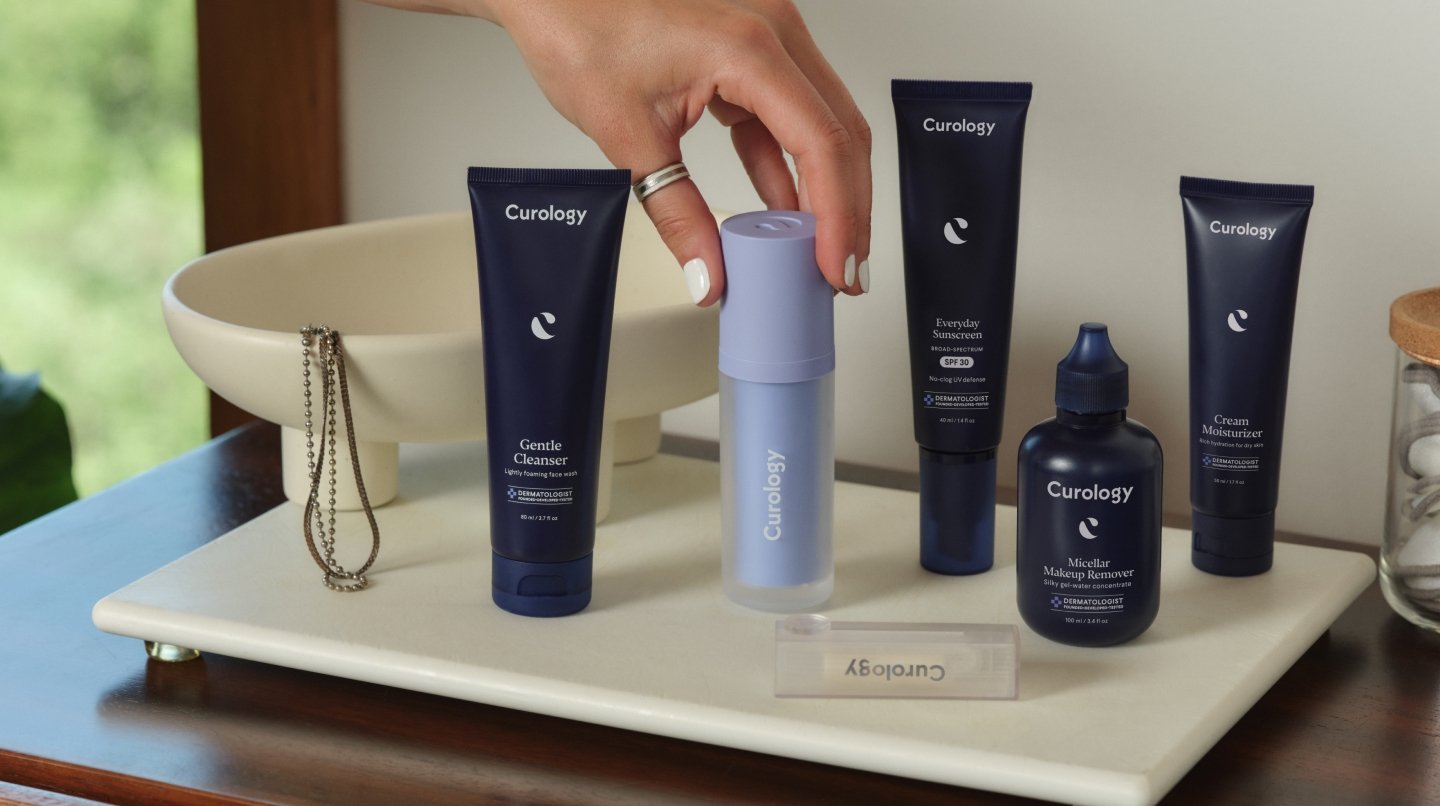How it works:
Share your skin goals and snap selfies
Your dermatology provider prescribes your formula
Apply nightly for happy, healthy skin
How it works:
How it works:
Share your skin goals and snap selfies
Your dermatology provider prescribes your formula
Apply nightly for happy, healthy skin
How it works:
Foods high in retinol: These may help your skin
A diet rich in retinol—aka vitamin A—may boost your skin health.



You’ve probably heard of retinol as a key ingredient in many skincare products, but did you know it’s a type of vitamin A? Consuming vitamin A is another way to reap the benefits of retinol, and there are many different ways to get more of it in your diet. Here we’ll give you a breakdown of foods high in retinol and how they may boost the health of your skin and body.
The importance of vitamin A
Vitamin A is a general term for fat-soluble substances such as retinol, retinyl palmitate, and beta-carotene. A superstar nutrient and antioxidant, vitamin A is essential for vision, cellular differentiation, immune function, and epithelial barrier function.¹ It helps the human body form organs such as the heart, eyes, and lungs.
There are two sources of vitamin A in the human diet. Preformed vitamin A (retinol and retinyl esters) is found in foods such as fish, eggs, dairy, and organ meats. Provitamin A (carotenoids) is derived from colorful fruits and veggies and is converted into vitamin A by the body.² Provitamin A carotenoids include beta-carotene, alpha-carotene, and beta-cryptoxanthin. Both forms of vitamin A must be converted to retinal and retinoic acid to support the body’s biological processes.³
So, is retinol vitamin A? Essentially, yes. This potent skincare ingredient is a retinoid—a vitamin A derivative. Potential vitamin A benefits for your skin and body include the following:
Fighting free radicals: Beta-carotene and other carotenoids—which are types of provitamin A—may function as antioxidants. These antioxidants may help prevent cancer by decreasing DNA-damaging free radicals. However, it should be noted that this benefit has only been shown to be effective in people who have a vitamin A deficiency. No cancer prevention has been proven in populations with sufficient dietary or supplemental vitamin A.⁴
Helping wounds heal: Vitamin A supplements may help restore impaired wound healing by promoting an inflammatory response in the body and increasing processes such as collagen synthesis.⁵
Aiding new cell growth: Getting enough vitamin A may regulate the growth and differentiation of some types of cells. It also may diminish malignant cell growth, another way it may help to prevent cancer.
Reducing inflammation: Retinoids, which are vitamin A derivatives, may reduce inflammation.
Fighting signs of aging: Studies show that topical (not dietary!) vitamin A application may help improve fine lines and wrinkles, roughness, and hyperpigmentation.
Foods high in vitamin A
Retinol’s natural sources are foods high in vitamin A. As mentioned above, there are two types of sources of vitamin A in foods: Preformed vitamin A and provitamin A (carotenoids). The first is primarily found in animal products, such as dairy products and cod liver oil, while carotenoids typically come from plants, including leafy greens. Both perform the same essential function. Here are some dietary sources of vitamin A:⁶
Beef liver: Three ounces of pan-fried beef liver contains 731% of your daily value of vitamin A.
Cantaloupe: One half-cup of raw cantaloupe contains 15% of your daily value of vitamin A.
Carrots: One half-cup of raw carrots contains 51% of your daily value of vitamin A.
Red bell pepper: One half-cup of raw red peppers contains 13% of your daily value of vitamin A.
Sweet potato: One whole baked sweet potato (with the skin) contains 156% of your daily value of vitamin A.
Spinach: One half-cup of boiled frozen spinach contains 64% of your daily value of vitamin A.
The human body may absorb 75-100% of retinol and 10-30% of beta-carotene from food, making it relatively easy to get vitamin A from your diet. Cooking and heat treatment can increase foods' bioavailability of provitamin A (beta-carotene).⁷

Recommended vitamin A intake
Taking too much vitamin A can be dangerous, so it’s important to know the recommended limits. The Institute of Medicine’s recommended dietary allowance (RDA) of vitamin A for healthy adults is 700 micrograms/day for women and 900 micrograms/day for men.⁸ You shouldn’t worry about going a little over this amount, but consuming excessive vitamin A for extended periods of time can lead to negative health effects. To be on the safe side, avoid eating beyond the recommended daily intake of vitamin A, especially if you’re pregnant or nursing.⁹ Symptoms of vitamin A toxicity may include the following:¹⁰
Vision changes, such as blurry sight
Bone pain
Nausea
Vomiting
Dry skin
Sensitivity to bright light
Vitamin A deficiency
It’s uncommon, but it is possible to experience vitamin A deficiency if you eat an unbalanced diet. The symptoms of severe vitamin A deficiency include the following:¹¹
Fatigue
Susceptibility to infection
Nyctalopia (night blindness)
Irregular patches on the whites of the eyes
Dry skin or hair
Infertility
Several conditions may prevent your body from absorbing vitamin A properly, including celiac disease, Crohn’s disease, cirrhosis, and cystic fibrosis.¹² If you experience any of these symptoms, get in touch with your healthcare provider.
Vitamin A and acne
Oral and topical vitamin A derivatives may be used to treat acne. Isotretinoin (formerly known by the brand name Accutane) is an oral retinoid derived from vitamin A that treats acne. That said, there are some potential side effects to take into consideration before starting this medication, including dry lips, dry skin, itching, facial redness, pregnancy complications, and skin irritation. The occurrence of these side effects is often dose dependent. This medication is available by prescription only and requires medical supervision. We don't prescribe isotretinoin at Curology, but we can help you find an in-person dermatologist who can!
Topical vitamin A derivatives, such as tretinoin (Retin-A) and adapalene, also treat acne, and they come with fewer risks. These topical treatments work by “unseating” comedones, and acne may improve over time. Topical application of vitamin Amay also help prevent the formation of new pimples, whiteheads, and blackheads.¹³

Curology is a full-service skincare membership offering products made with proven effective ingredients, including the vitamin A derivative tretinoin. You can review our helpful articles to learn more about the benefits of retinoids. Everyone’s skin is unique, which is why one of the most effective ways to treat signs of aging, acne, rosacea, and other skin concerns is with professional advice.
Curology’s skincare experts help take the guesswork out of your skincare routine. We work with you to determine the products your skin needs and create a personalized prescription formula to help you meet your skincare goals.
Signing up is easy. Just answer a few questions and snap some selfies to help us get to know your skin better. If Curology is right for you, we’ll pair you with one of our in-house licensed dermatology providers, who will be with you every step of the way.
FAQs
Vitamin A is a general term for fat-soluble substances such as retinol, retinyl palmitate, and beta-carotene. A superstar nutrient and antioxidant, vitamin A is essential for vision, cellular differentiation, immune function, and epithelial barrier function. It helps the human body form organs such as the heart, eyes, and lungs.
There are two types of sources of vitamin A in foods: Preformed vitamin A and provitamin A (carotenoids). The first is primarily found in animal products, such as dairy products and cod liver oil, while carotenoids typically come from plants, including leafy greens. Both perform the same essential function. Here are some dietary sources of vitamin A:
Beef liver: Three ounces of pan-fried beef liver contains 731% of your daily value of vitamin A.
Cantaloupe: One half-cup of raw cantaloupe contains 15% of your daily value of vitamin A.
Carrots: One half-cup of raw carrots contains 51% of your daily value of vitamin A.
Red bell pepper: One half-cup of raw red peppers contains 13% of your daily value of vitamin A.
Sweet potato: One whole baked sweet potato (with the skin) contains 156% of your daily value of vitamin A.
Spinach: One half-cup of boiled frozen spinach contains 64% of your daily value of vitamin A.
Taking too much vitamin A can be dangerous, so it’s important to know the recommended limits. The Institute of Medicine’s recommended dietary allowance (RDA) of vitamin A for healthy adults is 700 micrograms/day for women and 900 micrograms/day for men. You shouldn’t worry about going a little over this amount, but consuming excessive vitamin A for extended periods of time can lead to negative health effects. To be on the safe side, avoid eating beyond the recommended daily intake of vitamin A, especially if you’re pregnant or nursing.
P.S. We did the homework so you don’t have to:
McEldrew, EP., et al. Vitamin A. StatPearls. (2022).
Vitamin A and carotenoids. National Institutes of Health Office of Dietary Supplements. (2022).
McEldrew, EP., et al. Vitamin A. StatPearls. Ibid.
Dawson, MI. The importance of vitamin A in nutrition. Curr Pharm Des. (2000).
Keller, K., Fenske, N. Uses of vitamins A, C, and E and related compounds in dermatology: A review. Journal of the American Academy of Dermatology. (1998).
Vitamin A and carotenoids. National Institutes of Health Office of Dietary Supplements. Ibid.
Vitamin A and carotenoids. National Institutes of Health Office of Dietary Supplements.Ibid.
Hodge, C., Taylor, C. Vitamin A deficiency. StatPearls. (2022).
Vitamin A. NHS. (2020).
Vitamin A. The Nutrition Source. (n.d.)
Vitamin A. The Nutrition Source. Ibid.
Vitamin A. The Nutrition Source. Ibid.
Heel, RC., et al. Vitamin A acid: a review of its pharmacological properties and therapeutic use in the topical treatment of acne vulgaris. Drugs. (1977).
Kristen Jokela is a certified Family Nurse Practitioner at Curology. She obtained her Master of Science in Nursing at the University of South Florida in Tampa, FL.

Curology Team

Kristen Jokela, NP-C
Related Articles
How to use acne body wash correctly: Your straightforward guideMen skin care: top concernsHow to get rid of body and back acne?Face sunscreen for sensitive skinSunscreen for eyes: How to protect your delicate skin from UV raysPopular Articles
Ask Curology: Is my cold breaking me out?Slugging: The dermatologist-approved skincare hack going viral on TikTokTretinoin vs retinol: What’s the difference?How to create a self-care routine that actually sticksYour 2023 skincare horoscopeTry prescription skincare
Get routine essentials

Good skin days ahead
- Breakouts
- Redness
- Fine lines
- Dark spots
- Hair thinning